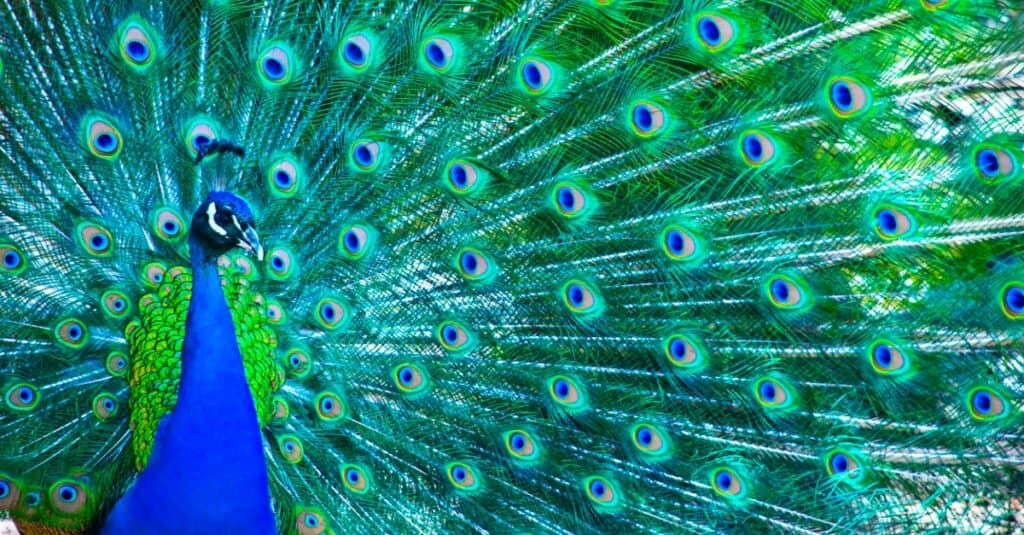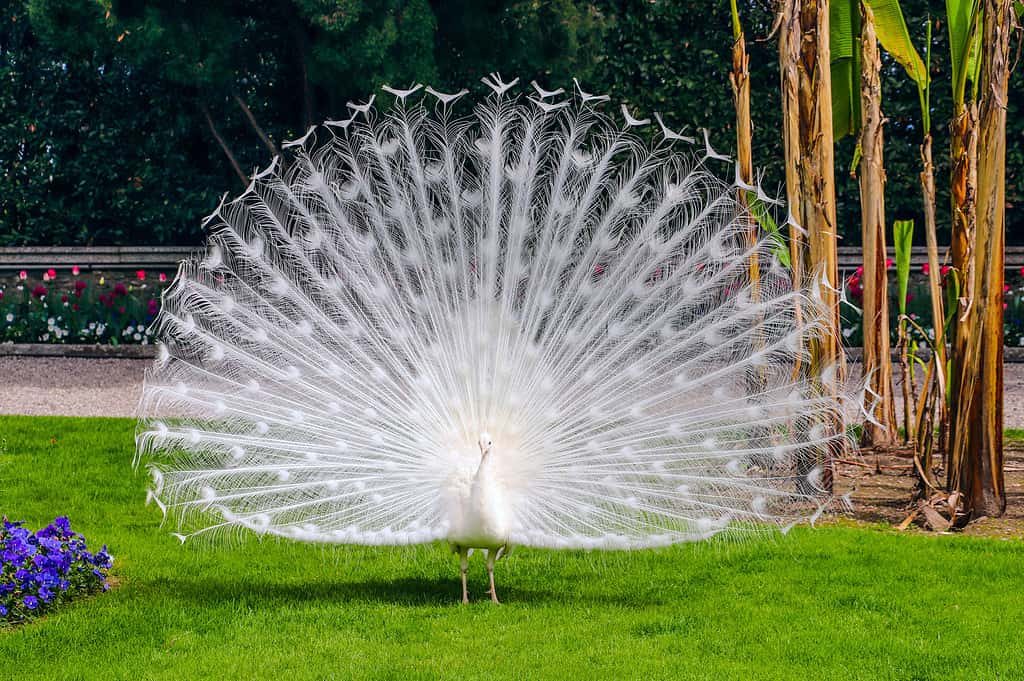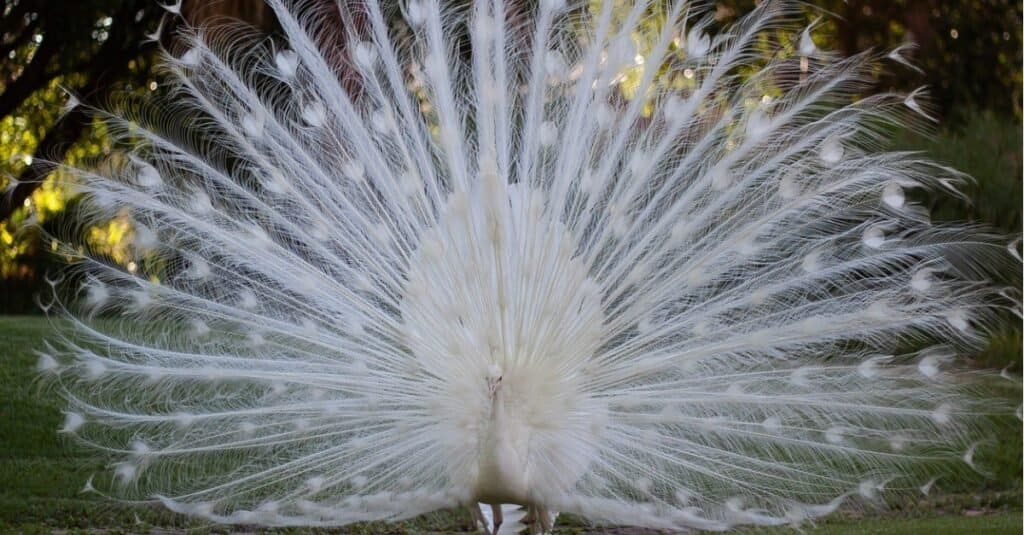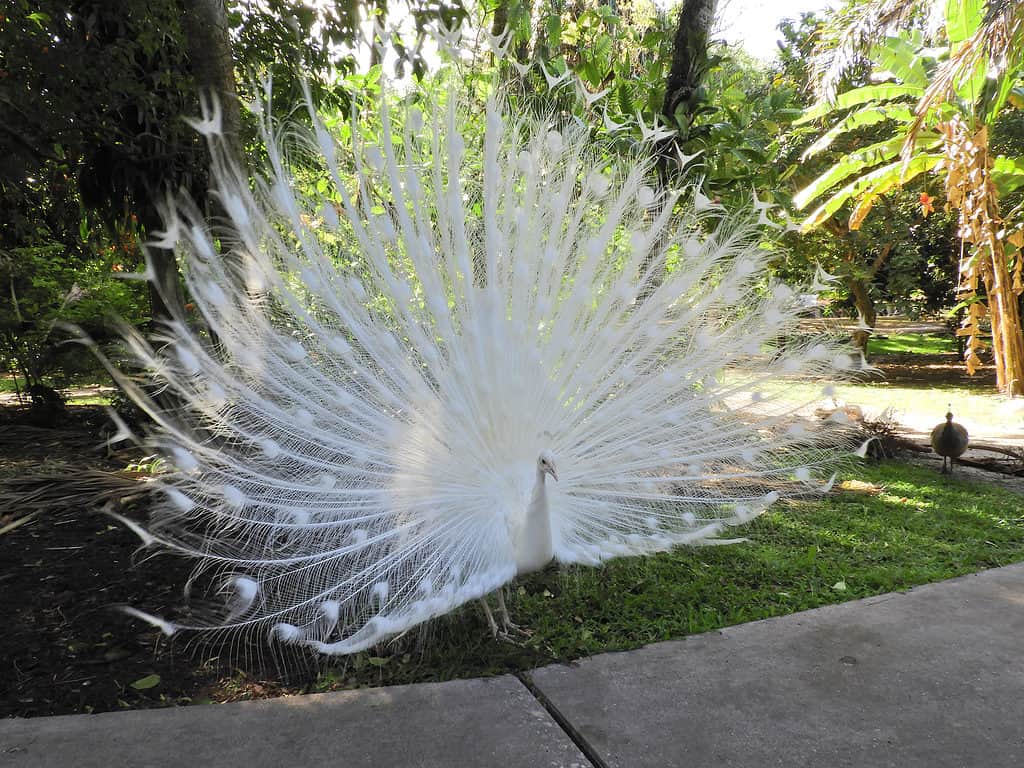Peafowl, of which the males are called peacocks and the females are called peahens, are three species of birds that are often referred to simply as peacocks. Males are known for their beautiful, large tail feathers that are used to attract mates and ward off predators. While many peacocks most often appear blue, green, brown, and grey, often with iridescent feathers, they can sometimes appear white. Discover what causes white peacocks, see pictures of these ethereal creatures, and learn why they’re so rare!
For the sake of appealing to the colloquial identity of these birds, we’ll be calling them peacocks throughout this article.
What Are Typical Peacock Colors?

Three species of peacocks exist, and they are the Indian peafowl, the Congo peafowl, and the green peafowl.
©iStock.com/AlexeyVis
Male peafowls have more brightly colored plumage and body feathers compared to females. Still, that doesn’t mean females don’t have a variety of colors in their feathers.
Three species of peacocks exist, and they are the Indian peafowl, the Congo peafowl, and the green peafowl. The Congo peafowl hails from Africa while the Indian peafowl is from the Indian subcontinent and the green peafowl lives in Southeast Asia.
Given all three species of birds, some of the most typical peacock colors include:
- Blue
- Green
- Purple
- Turquoise
- Gray
- Brown
- Copper
These aren’t all the colors of peacocks. Also, peafowl breeders recognize many color morphs. So, it’s safe to say that a white peacock is not a common occurrence. In fact, they’re exceptionally rare that can only come about as a result of two different processes.
What Are White Peacocks?

If you see a white peacock, the chances are very good that it is a leucistic Indian peafowl rather than an albino one.
©Easy going/Shutterstock.com
White peacocks are either leucistic or albino peacocks. No species of peacock is naturally white. White peacocks apparently only come from the Indian peafowl species or are vastly more common in that species. Even then, the appearance of leucistic or albino peacocks is incredibly rare, with albino peacocks being far rarer than leucistic peacocks.
Thus, if you see a white peacock, the chances are very good that it is a leucistic Indian peafowl rather than an albino one.
Leucistic peacocks are interesting because they are not born white. Instead, the chicks begin growing yellow feathers that eventually turn white as the creature matures.
What Causes White Peacocks?

While albino peacocks do exist, they are not as common as leucistic ones.
©kipgodi/Shutterstock.com
White peacocks result from two types of anomalies in birds. They are leucism and albinism. Both of these result in white coloration, but their root causes are different.
Leucism occurs as a result of a genetic mutation that causes a partial loss of pigmentation in various creatures. In some cases, leucism causes all of a creature’s fur or feathers to appear white. However, leucistic creatures may not appear entirely white.
In some cases, like white squirrels, the creature often retains a small patch of fur on their heads as well as a dorsal stripe of color on their backs.
Leucism may seem like albinism at first glance. While albino peacocks do exist, they are not as common as leucistic ones. Also, albino peacocks have some notable differences. For one thing, the mechanism that causes the bird to appear white is different, and so is the outcome.
Albinism restricts the body’s ability to produce or distribute melanin. That’s different than the mechanism that occurs in leucistic birds, and the results are different too. In peacocks, one easy way to tell is by looking at the eyes. Albino peacocks will have pink eyes while leucistic peafowl will retain color in their eyes, often blue.
Most if not all white peacocks belong to the Indian peacock species. One reason that this species continues to appear white is that some zoos and private collectors selectively breed them to pass on their traits and make more white peacocks. Of course, it’s not always a sure thing, but a greater concentration of white peacocks exists in captivity than in the wild.
Do These Birds Get Any Evolutionary Advantages?

Peacocks spread their feathers in part to help scare off predators.
©iStock.com/D-Art Photography
Sometimes, animals that appear with a mutation will get some sort of benefit that makes the trait continue in the species. White peacocks do not get much of a benefit from their coloration. That holds true for leucistic peacocks along with albino peacocks.
Albino peacocks would probably have a lower quality of life since albinism in animals is tied to poor eyesight. Peacocks use their vision to spot the bugs and other creatures they eat and to help them avoid predators. Not having such a good ability to see could lead albino white peacocks to suffer in the wild.
Meanwhile, leucistic white peacocks primarily live in captivity. That means the only benefit of their lack of pigmentation is that humans find them interesting to look at. Otherwise, they would probably stand out more in their natural environment, making them easier for predators to find.
How Rare Are White Peacocks?

No solid figures concerning the population of white peacocks currently exist.
©iStock.com/simona flamigni
Nobody knows just how many white peacocks exist in the world today. They are listed by the IUCN as being a species of “least concern.” Some estimates claim that upwards of 100,000 of these creatures exist in the world.
Leucism is a very rare condition, so it’s safe to assume that just a few thousand of these white peacocks may exist.
No solid figures concerning the population of white peacocks currently exist. Some estimates say that the chance that a white peacock will be born is about one in 30,000. That does not account for selective breeding in captivity, though.
White peacocks are the result of leucism and albinism. While leucistic white peacocks are far more common than albino peacocks, both types are incredibly rare. The majority of white peacocks exist in captivity these days. Thus, seeing a white peacock is not all that difficult so long as a person takes the time to find one in a zoo or private collection near them.
How Much is a White Peacock Worth?

White peacocks are a favorite choice of many people, including hobbyists and poultry fanciers who consider them a novelty.
©kipgodi/Shutterstock.com
Compared to a standard colored peacock, these white genetically mutated peacocks are in high demand, and in certain areas of the world, people are willing to pay a lot of money. These leucistic birds can go for as high as $1500 from an established breeder, while the regular Indian blue varieties will go for around $50 to $60 dollars. They are even sold online, with some sites charging over $275 per bird, while other sites have prices starting at $665 for a breeder male, and $833 for a breeder female.
A favorite choice of many people, including hobbyists and poultry fanciers who consider them a novelty, they are in high demand. There are even instances of them being used for bridal parties. Thought to be symbols of love or purity, white peacocks are rare and are most likely a result of selective breeding.
The photo featured at the top of this post is © Michelle Silke/Shutterstock.com
Thank you for reading! Have some feedback for us? Contact the AZ Animals editorial team.






